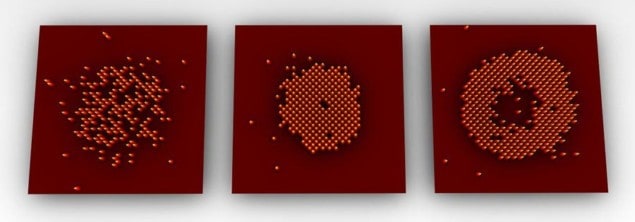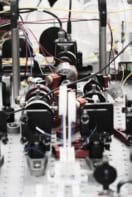
Physicists in Germany have used fluorescence imaging to identify individual particles in an optical lattice for the first time. The breakthrough could allow researchers to create more advanced simulations of quantum phenomena and it might help in the quest for practical quantum computing.
Optical lattices are regular arrays of identical energy wells created by criss-crossing laser beams. By injecting ultracold atoms into the energy wells, the lattices can be used to create and study a range of materials and they are used to create large-scale replicas of quantum systems.
In this new research, Stefan Kuhr and Immanuel Bloch of the Max Planck Institute of Quantum Optics in Garching, together with colleagues at Ludwig-Maximilians University in Munich, created an optical lattice to contain a type of ultracold gas known as a Bose-Einstein condensate (BEC). These systems are formed when identical atoms with integer spin are cooled until all the atoms are in the same quantum state, meaning they behave as if they were a single quantum particle.
‘Dark and bright’ regions
Kuhr’s team created its BEC by cooling several thousand rubidium-87 atoms to close to absolute zero, and then configured the optical lattice to form a series of “dark and “bright” areas. Due to the energy levels, the rubidium atoms are much more likely to settle in the dark regions, and to hop into neighbouring sites each atom would have to overcome a significant energy barrier. This configuration is known as a Mott insulator, named after British physicist and Nobel prize winner Sir Neville Mott, because it resembles a solid in which conduction electrons are localized due to the strong interactions between the atoms.
According to theory, the number of atoms varies between lattice sites in a BEC. In the case of a Mott insulator though, this number is predicted to approach a fixed value at very low temperatures close to zero Kelvin – with the atoms arranged regularly in each lattice site. Kuhr’s team has now been able to directly observe this behaviour in an experiment for the first time.
Scientists regularly cool atoms using laser beams in quantum optics systems. But the key was to fire laser pulses at the system and then directly detect the atoms using a specially designed high-resolution microscope that collects the fluorescence photons from the atoms as they cool. It was using this technique that the researchers were able to count single atoms on each individual lattice site – a “sensational result”, says Kuhr, “and a prerequisite for using these systems as quantum registers with individually addressable quantum bits in future quantum computers”.
A quantum register
“A Mott insulator with exactly one atom per lattice site represents a very promising candidate for a quantum register of up to a few hundred atomic quantum bits,” adds Kuhr. “However, we needed to show that we really are able to manipulate each individual atom in the structure. This is crucial for encoding and reading out qubits and we are now at the beginning of setting up the first experiments of this kind.”
These studies might not only lead to quantum computers; they could also help to develop fundamental models of condensed matter physics. This is because the atoms in an optical lattice are analogous to the electrons in a solid state crystal. “Such investigations could aid in our understanding of unusual magnetic and electric phenomena, such as high-temperature superconductivity, and may even pave the way towards ‘tailor-made’ materials,” said Kuhr.
The work is described in Nature.



